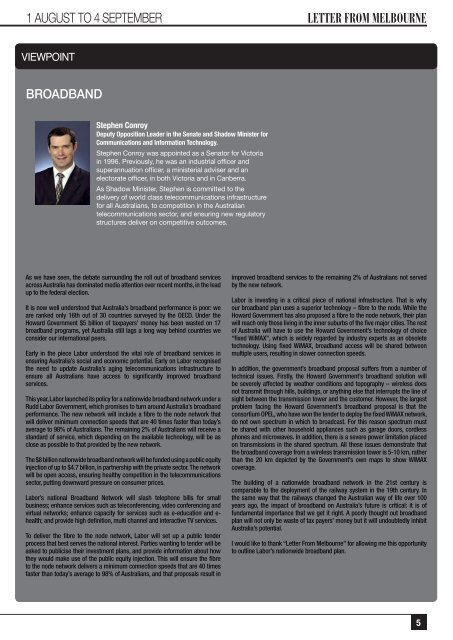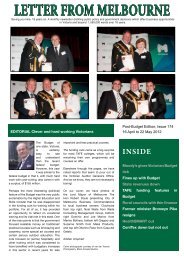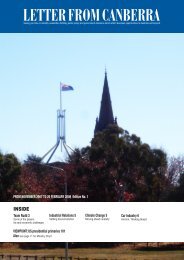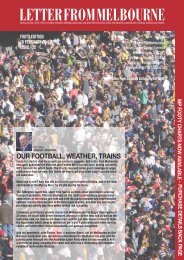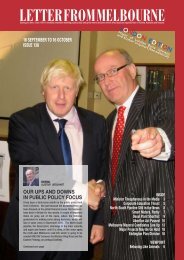LETTER FROM MELBOURNE
LETTER FROM MELBOURNE
LETTER FROM MELBOURNE
You also want an ePaper? Increase the reach of your titles
YUMPU automatically turns print PDFs into web optimized ePapers that Google loves.
1 AUGUST TO 4 SEPTEMBER<br />
<strong>LETTER</strong> <strong>FROM</strong> <strong>MELBOURNE</strong><br />
VIEWPOINT<br />
Broadband<br />
Stephen Conroy<br />
Deputy Opposition Leader in the Senate and Shadow Minister for<br />
Communications and Information Technology.<br />
Stephen Conroy was appointed as a Senator for Victoria<br />
in 1996. Previously, he was an industrial officer and<br />
superannuation officer, a ministerial adviser and an<br />
electorate officer, in both Victoria and in Canberra.<br />
As Shadow Minister, Stephen is committed to the<br />
delivery of world class telecommunications infrastructure<br />
for all Australians, to competition in the Australian<br />
telecommunications sector, and ensuring new regulatory<br />
structures deliver on competitive outcomes.<br />
As we have seen, the debate surrounding the roll out of broadband services<br />
across Australia has dominated media attention over recent months, in the lead<br />
up to the federal election.<br />
It is now well understood that Australia’s broadband performance is poor: we<br />
are ranked only 16th out of 30 countries surveyed by the OECD. Under the<br />
Howard Government $5 billion of taxpayers’ money has been wasted on 17<br />
broadband programs, yet Australia still lags a long way behind countries we<br />
consider our international peers.<br />
Early in the piece Labor understood the vital role of broadband services in<br />
ensuring Australia’s social and economic potential. Early on Labor recognised<br />
the need to update Australia’s aging telecommunications infrastructure to<br />
ensure all Australians have access to significantly improved broadband<br />
services.<br />
This year, Labor launched its policy for a nationwide broadband network under a<br />
Rudd Labor Government, which promises to turn around Australia’s broadband<br />
performance. The new network will include a fibre to the node network that<br />
will deliver minimum connection speeds that are 40 times faster than today’s<br />
average to 98% of Australians. The remaining 2% of Australians will receive a<br />
standard of service, which depending on the available technology, will be as<br />
close as possible to that provided by the new network.<br />
The $8 billion nationwide broadband network will be funded using a public equity<br />
injection of up to $4.7 billion, in partnership with the private sector. The network<br />
will be open access, ensuring healthy competition in the telecommunications<br />
sector, putting downward pressure on consumer prices.<br />
Labor’s national Broadband Network will slash telephone bills for small<br />
business; enhance services such as teleconferencing, video conferencing and<br />
virtual networks; enhance capacity for services such as e-education and e-<br />
health; and provide high definition, multi channel and interactive TV services.<br />
To deliver the fibre to the node network, Labor will set up a public tender<br />
process that best serves the national interest. Parties wanting to tender will be<br />
asked to publicise their investment plans, and provide information about how<br />
they would make use of the public equity injection. This will ensure the fibre<br />
to the node network delivers a minimum connection speeds that are 40 times<br />
faster than today’s average to 98% of Australians, and that proposals result in<br />
improved broadband services to the remaining 2% of Australians not served<br />
by the new network.<br />
Labor is investing in a critical piece of national infrastructure. That is why<br />
our broadband plan uses a superior technology – fibre to the node. While the<br />
Howard Government has also proposed a fibre to the node network, their plan<br />
will reach only those living in the inner suburbs of the five major cities. The rest<br />
of Australia will have to use the Howard Government’s technology of choice<br />
“fixed WiMAX”, which is widely regarded by industry experts as an obsolete<br />
technology. Using fixed WiMAX, broadband access will be shared between<br />
multiple users, resulting in slower connection speeds.<br />
In addition, the government’s broadband proposal suffers from a number of<br />
technical issues. Firstly, the Howard Government’s broadband solution will<br />
be severely affected by weather conditions and topography – wireless does<br />
not transmit through hills, buildings, or anything else that interrupts the line of<br />
sight between the transmission tower and the customer. However, the largest<br />
problem facing the Howard Government’s broadband proposal is that the<br />
consortium OPEL, who have won the tender to deploy the fixed WiMAX network,<br />
do not own spectrum in which to broadcast. For this reason spectrum must<br />
be shared with other household appliances such as garage doors, cordless<br />
phones and microwaves. In addition, there is a severe power limitation placed<br />
on transmissions in the shared spectrum. All these issues demonstrate that<br />
the broadband coverage from a wireless transmission tower is 5-10 km, rather<br />
than the 20 km depicted by the Government’s own maps to show WiMAX<br />
coverage.<br />
The building of a nationwide broadband network in the 21st century is<br />
comparable to the deployment of the railway system in the 19th century. In<br />
the same way that the railways changed the Australian way of life over 100<br />
years ago, the impact of broadband on Australia’s future is critical: it is of<br />
fundamental importance that we get it right. A poorly thought out broadband<br />
plan will not only be waste of tax payers’ money but it will undoubtedly inhibit<br />
Australia’s potential.<br />
I would like to thank “Letter From Melbourne” for allowing me this opportunity<br />
to outline Labor’s nationwide broadband plan.


